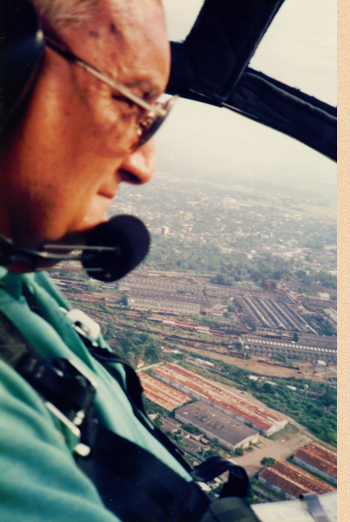conservation and climate change

Ray Wijewardene had a life-long interest in environmental conservation and natural resource management -- but not from a narrow viewpoint of a single species or ecosystem. He took the systemic view instead, and identified both problems and opportunities for doing things right: for example, by improving resource and energy use efficiencies, and in mimicking Nature in search of solutions.
For example, he was concerned with the profligate use of water in tropical rice farming: on average, 20 tons of water being used to produce a single kilogram of rice.
His analysis showed that three quarters of this water was simply for suppressing weeds in the paddy fields, and not for any physiological needs of the rice plant. Anticipating global water shortages in the 1990s, he cautioned:
 Water is rapidly becoming the most expensive herbicide in the world — and freshwater is increasingly scarce! Water is rapidly becoming the most expensive herbicide in the world — and freshwater is increasingly scarce! - Ray Wijewardene |
Similarly, he was one of the first to sound the alarm about vehicle exhaust emissions building up to create serious problems of air pollution in Sri Lanka. In the early 1980s, Ray spoke about a haze he and other pilots had observed hanging over Greater Colombo, usually between 800 to 1,800 feet above ground level. As motorised transport use increased, so did the area covered by the haze.
Other pilots just flew to higher altitudes for clearer skies. But the scientist in Ray made him probe further. He found that the haze was “caused by our own air pollution: micro particulates released into the air by partial combustion of imported petroleum fuels have formed nuclei upon which moisture in our normally humid airs have coalesced.”
 As a farmer, he was worried about this umbrella-like cover of cloud reducing the amount of sunlight falling on to the ground. He suggested that coconut yields were declining partly as a result of this sunlight deprivation. So air pollution was not only making people sick; they were also affecting agricultural crops.
As a farmer, he was worried about this umbrella-like cover of cloud reducing the amount of sunlight falling on to the ground. He suggested that coconut yields were declining partly as a result of this sunlight deprivation. So air pollution was not only making people sick; they were also affecting agricultural crops.
While Ray favoured organic farming that was closer to Nature, he was not fundamentally opposed to external inputs like chemical fertiliser. He recognised the critical need to maintain soil fertility.
He said: “Sri Lanka doesn’t have extensive chemical deposits like India to produce all its own chemical replenishment. So we need to import some chemical fertilizers -- but it must be used sparingly and alongside the natural ways of fertilizing the land. We need to pay more attention to aspects such as green manure, cow dung and earthworms – these are the real friends of farmers!”
In the last decade of his life, he was preoccupied climate change, both its mitigation and adaptation aspects. He showed how investing more in renewable energy could enable Sri Lanka to achieve a low-carbon path to economic development. He urged for rethinking of the country’s transport policy and practices to reduce dependence on imported oil.
He also saw the need for more targeted research, asking scientists to develop crop varieties more resilient to drought, salinity and higher temperatures. He advocated carbon bio-sequestration with large scale growing of plants like maize, sugarcane and bamboo that were particularly efficient in carbon capture through photosynthesis (known as C-4 plants). He wondered if rice and coconut could and should be genetically manipulated to become C-4.

Ray grasped the magnitude of the climate crisis, but also saw it as an opportunity. As he noted in mid 2008 in a TV show: “Climate change challenges us to rethink all our energy and land use practices -- something we should have done years ago."
For further discussions, see:
Who Speaks for Small Farmers, Earthworms and Cow Dung?
Ray Wijewardene in conversation with Nalaka Gunawardene (interview recorded in 1995; full text published on Groundviews.org, in August 2010)
![]() Fresh paradigm for a permanent truce with Nature
Fresh paradigm for a permanent truce with Nature
Speech delivered by Ray Wijewardene at the establishment of the Sri Lanka Sustainable Energy Authority on 24 October 2007
